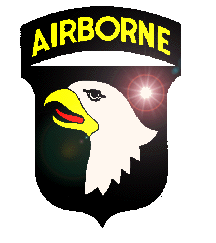


Eagles History
In the Beginning . .
Upon the activation of the 101st Airborne Division on 16 August 1942 at Camp Clairborne, Louisiana, Major General William C. Lee observed that "The 101st...has no history, but it has a rendezvous with destiny." Time and time again, the 101st has kept that rendezvous and in so doing, has acquired a proud history.
The 101st Airborne Division traces its lineage
to World War I with the formation of the 101st Division on 23
July 1918, which was demobilized 11 December 1918 has a result of
the armistice. In 1921, the 101st Infantry Division reconstituted
and reorganized as a reserve unit with headquarters in Milwaukee,
Wisconsin. On 15 August 1942, the division disbanded as a
reserve unit and activated in the United States Army as the 101st
Airborne Division.
25 June 1940
Following the suggestion of Major William C. Lee, the War Department formed the first parachute unit, a test platoon, at Fort Benning, Georgia, on 25 June 1940. This platoon, consisting of volunteers from the 29th Infantry Regiment, made Its first jump on 16 August 1940. The success of the unit led to the establishment of several parachute battalions and regiments during the following two years.
In 1942, Major Lee, by now Brigadier General, endorsed the concept of airborne divisions after studying the British Army use of parachute troops during the early years of World War II. The commander of Army Ground Forces, Lieutenant General Lesley J. McNair, concurred with Lee's recommendation and ordered the formation of the 82nd and 101st Airborne Divisions. Initial personnel and equipment for both divisions came from the 82nd Motorized Infantry Division which deactivated at the same time. Brigadier general Lee assumed command of the 101st Airborne Division on 19 August 1942.
Originally, the 101st had one parachute regiment (the 502nd Parachute Infantry), two glider regiments (the 327th and the 401st Glider Infantry), and three artillery battalions (the 377th Parachute Field Artillery, the 321st Glider Field Artillery, and the 907th Glider Field Artillery). Additional support units were the 326th Airborne Engineer Battalion, the 101st Signal Company, the 326th Airborne Medical Company, and the 426th Airborne Quartermaster Company.
Organizing and training the new division was a challenge. In October, 1942, the 101st began rigorous training at Fort Bragg, North Carolina. Throughout the fall and winter, General Lee helped to establish a whole new tactic of warfare - the use of airborne troops in battle.
In June of 1943, the 101st received a second parachute
infantry regiment, the 506th, from Camp Toccoa, Georgia. The 506th
had trained in the shadow of Currahee Mountain and had adopted
the name "Currahee" as its motto. That summer the
Division proved itself during the Second Army Maneuvers and in
September deployed to England.